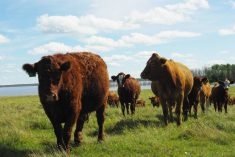Western Canadian feeder cattle markets were trading $5-$7 above week-ago levels, with higher-quality cattle trading as much as $10 higher. It’s difficult to quarrel with one’s bread and butter; feedlot margins are now in positive territory and cattle feeders are keen on ownership with the positive outlook into the March timeframe.
Feature presort calf sales were noted across the eastern Prairie regions, drawing strong buying interest from larger feedlot operations on all weight categories. Lighter-weight calves under 500 lbs. were well bid, with major feedlots looking to secure a yearling supply for next spring at decent values. Available numbers are drawing down in Alberta’s Foothills region and late in the week, Manitoba markets appeared to hold a slight premium over Alberta. Favourable weather once again narrowed the spread on weaned and unweaned calves; however, cow-calf producers were rewarded putting on the additional pounds.
Read Also

U.S. livestock: Feeder cattle hit contract highs on tight supply
Chicago | Reuters – All Chicago Mercantile Exchange feeder cattle futures and most live cattle futures hit contract highs on…
Black Angus-based steers weighing just under 500 lbs. reached up to $220 in central Alberta but 450- to 500-lb. steers readily traded from $218 to $224. A smaller group of Simmental-cross mixed steers weighing from 500 to 530 lbs. traded for $200 in southern Manitoba and the market was fairly flat across the Prairies on these types of cattle. Larger-frame 600-lb. mixed heifers were quoted at $166 in central Alberta while 650-lb. mixed steers sold for $181 in western Saskatchewan. Larger-frame medium-flesh weaned 700-lb. Charolais-base steers were quoted at $189 landed in southern Alberta. Black mixed heifers averaging just over 750 lbs. were quoted at $163 landed in the Lethbridge area.
Alberta packers were buying fed cattle from $145 to $146 with the deferred March April delivery positions slightly higher. The U.S. Department of Agriculture’s bearish cold storage report has been factored into the market and traders are focusing on a shorter supply situation moving forward. Financial markets appear to favour the Trump tax and economic policies, which will enhance consumer spending and bode well for beef consumption, especially for the lower-income 10 per cent of the population. There are still 45 million Americans on food stamps despite the unemployment rate dropping under five per cent. Longer-term, higher incomes across all wage demographics will stimulate beef demand.
— Jerry Klassen is manager of the Canadian office for Swiss-based grain trader GAP SA Grains and Produits. He is also president and founder of Resilient Capital, which specializes in proprietary commodity futures trading and commodity market analysis. Jerry owns farmland in Manitoba and Saskatchewan but grew up on a mixed farm/feedlot operation in southern Alberta, which keeps him close to the grassroots level of grain and cattle production. Jerry is a graduate of the University of Alberta. He can be reached at 204-504-8339.
















